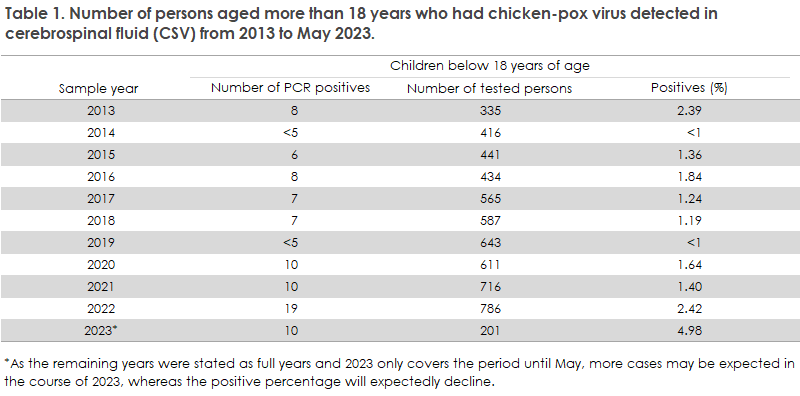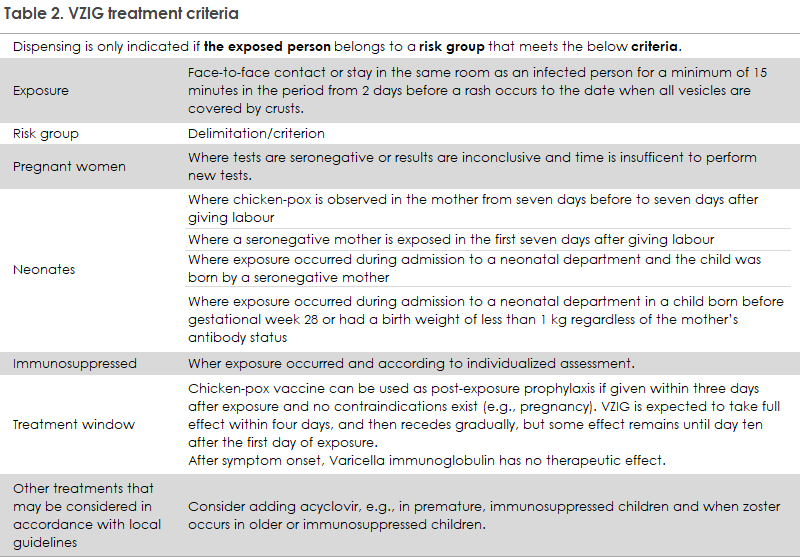No 19/20 - 2023
You can now sign up for “News from the SSI’s Infection Preparedness Service” to receive breaking news from Statens Serum Institut directly in your in-tray.
Chicken-pox in Denmark from 2013 to 2023
You can now sign up for “News from the SSI’s Infection Preparedness Service” to receive breaking news from Statens Serum Institut directly in your in-tray.
Healthcare workers and professionals, the media and anyone wanting to know more can now sign up to the novel newsletter “News from the SSI’s Infection Preparedness Service”, which was first published on Thursday 13 April, and receive the newsletter directly in your in-tray.
As a novelty, it is now possible to sign up for the newsletter. You can do so right here: News from the SSI’s Infection Preparedness Service
Usually every second Thursday, the SSI releases brief news about infectious threats, outbreaks and epidemics, among others, that threaten the health of humans and animals alike.
You will have “News from the SSI’s Infection Preparedness Service” sent directly to your in-tray for the first time on 25 May if you sign up to receive the newsletter.
(Statens Serum Institut)
Chicken-pox in Denmark from 2013 to 2023
Currently, signs are being observed of an increase in the number of chicken-pox cases in Denmark. Chicken-pox is not a notifiable disease, and its prevalence is therefore not monitored systematically. In recent months, the SSI has observed an increase in the number of enquiries regarding non-immune pregnant women who have become affected by chicken-pox. Additionally, the SSI has received notifications from paediatricians informing of an increased occurrence of hospital contacts with children with chicken-pox and associated complications.
Chicken-pox is a common childhood condition caused by infection with the varicella-zoster virus (VZV). Chicken-pox presents as slight fewer, affected general state and development of a characteristic rash with blisters and itching. Chicken-pox typically runs a mild disease course, but it may give rise to complications, including secondary skin infections among others. In very rare cases, chicken-pox may lead to complications from the central nervous system. After the primary infection, the virus hibernates in the nerve cells and may, later in life, become reactivated as the shingles (herpes zoster). Pregnant women who have not previously had chicken-pox or received chicken-pox vaccination carry an increased risk of running a serious disease course.
Chickenpox is infectious from two days before the rash presents and until all vesicles are covered by crust. Transmission is by secretion from the airways and aerosoles, and from the lesions. The incubation period ranges from 10 to 21 days, most frequently 14 days. A singles rash also contains chicken-pox virus and is infectious to persons who have not previously had chicken-pox; however, infection usually requires closer contact because of the more limited extension of the rash and as virus is not excreted from the airways.
It is assumed that the annual number of chicken-pox cases in Denmark equals the number of children in a birth year as the virus is very infectious and nearly all children become infected with chicken-pox. This corresponds to approx. 60,000 annual chicken-pox cases in Denmark. However, in adults from tropical or subtropical climate zones, the share of immune persons may be considerably lower. Within Europe, the share of immune adults also varies as adults from South and East Europe are more frequently non-immune than are adults from North and West Europe.
Based on the potentially increased occurrence of chicken-pox, the SSI herein reports the number of hospital contacts with chicken-pox recorded in the National Patient Registry in the past ten years.
Additionally, data from the Danish Microbiology Database (MiBa) were used to establish the number of children in whom chicken-pox virus was found in the cerebrospinal fluid as a sign of complications from the central nervous system.
Hospital contacts with chicken-pox from 2013 to May 2023
Figures from the National Patient Registry show that in the period from 2013 to May 2023, a total of 5,035 children had hospital contacts that involved being diagnosed with chicken-pox. In all, 4,125 of these children were between zero and five years of age. Figure 1 shows that seasonal variation exists, and the largest share of contacts is observed in the second quarter of the year. However, during the COVID-19 pandemic in 2020 and 2021, fewer hospital contacts were recorded with chicken-pox in all quarters. In 2022, a large number of hospital contacts was initially recorded; however, for the year as a whole, the number of contacts was on a par with the previous years. So far, 2023 has recorded approx. 300 contacts with chicken-pox, which is more than in the first quarter of any preceding year. Overall, Figure 1 shows that approx. 500 children come into contact with Danish hospitals annually due to chicken-pox, which is less than 1% of the expected number of chicken-pox cases.

Central nervous system complications to chicken-pox
Table 1 shows how many children and persons aged more than 18 years had chicken-pox virus detected in the cerebrospinal fluid from 2013 to May 2023. The data is based on the Danish Microbiology Database (MiBa) and includes PCR analyses by which DNA is detected. The statement shows that the number of children who have had chicken-pox virus detected in the cerebrospinal fluid is higher than previously in 2022 when 19 cases were detected, and in 2023 when ten cases have so far been detected. The occurrence increased even though the total number of tests remained stable. Overall, chicken-pox virus is rarely found in the cerebrospinal fluid in children (less than 0.02% of the expected 60,000 annual chicken-pox cases).

Risk groups, including pregnant women
Chicken-pox may give rise to complications in non-immune pregnant women and their unborn children and in neonates. The SSI handles the dispensing of Varizella Zoster Immunoglobulin (VZIG) for physicians (normally only from gynaecologic-obstetric departments) who contact the SSI about pregnant women who have possibly been exposed to chicken-pox infection and who have not previously had the condition or received vaccination. In 2022, the SSI dispensed VZIG in 30 such cases compared with an average 20 cases in the preceding years.
Not all Danes have had chicken-pox in childhood, and many Danes grew up in countries where chicken-pox occurs less frequently than in the Nordic countries. The SSI assesses that a risk of infection exists if you are pregnant and unsure if you have had chicken-pox in childhood and are therefore immune to chicken-pox, and have been in the same room as or have had face-to-face contact for more than 15 minutes with a person who has chicken-pox.
Chicken-pox vaccine can be used as post-exposure prophylaxis if given within three days after exposure, but VZIG is given in pregnant women, for instance.
VZIG is a human immunoglobulin derived from donor plasma with high VZV antibody titres. In both healthy and immunosuppressed children who are seronegative and exposed to chicken-pox, VZIG has been demonstrated to reduce the seriousness of disease caused by chicken-pox or to completely prevent chicken-pox disease.
For physicians treating infants, the below table (Table 2) may serve as a guide when establishing when the SSI should be contacted for dispensing of post-exposure prophylaxis in the form of Varicella Zoster Immunglobulin (VZIG).

Summary
The overall scenario indicates that the occurrence of chicken-pox increased in 2022 and 2023 following two years with a presumed lower level of infection in 2020 and 2021 as was the case for several other infectious diseases. The SSI expects a continued high occurrence of chicken-pox in the near future. The occurrence of chicken-pox complications will follow the number of chicken-pox cases in the population. Physicians and, in particular, paediatricians and obstetricians are encouraged to remain attentive to chicken-pox complications and to stay aware that with the current high chicken-pox occurrence several vulnerable groups, including non-immune pregnant women, may have been exposed to chicken-pox infection and should therefore be offered post-exposure prophylaxis.
You will find more information about chicken-pox below along with a link to information about diagnostics and other information of relevance to healthcare professionals.
The SSI disease encyclopaedia (SSI’s Sygdomsleksikon) entry on chicken-pox
Here, the same definition was used of a chicken-pox contact in the NPR as in Glode Helmuth I, et al. (chicken-pox was registered as the main or a supplementary diagnosis). However, the data were not filtered for duration of hospitalisation and therefore this is a statement of hospital contacts rather than admissions. Glode Helmuth I, et al. Children Hospitalized With Varicella in Denmark: Sensitivity of the National Patient Register. Pediatr Infect Dis J. 2017 Jan;36(1):31-35. doi: 10.1097/INF.0000000000001347. PMID: 27749656.
(F. Trier Møller, Department of Infectious Disease Epidemiology and Prevention, U. Vest Schneider, K. Træholt Franck, Virus & Microbiological Special Diagnostics, J. Elskær Mollerup, S. Schytte Olsen, S. Gubbels, DIAS)
17 May 2023